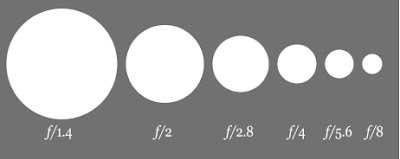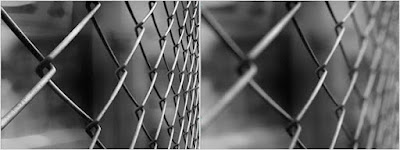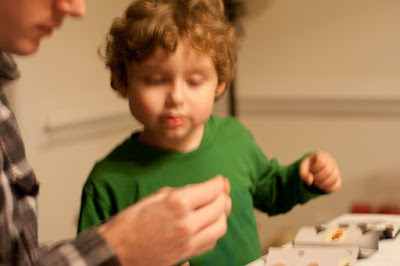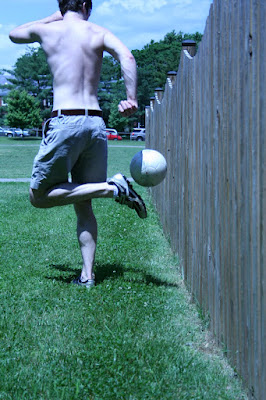So, it's been a year since I started this blog, and I thought this would be a good time to reflect on what I've learned about my camera(s!) and about photography since then.
I'm hoping to write this post in a way that will help other beginning DSLR users who are as confused as I was about the manual settings of their cameras.
I remember that my biggest question when I was learning how to properly use the manual settings on my Canon 350D was what settings to change when. (Isn't that the only question? :))
I dumped myself right into the learning curve and started using M mode all the time -- never Av, and never Pv (I now use mostly Av).
So, what's the No. 1 thing I've learned?
It's all about light.In that light (ha! punny!), I learned about my camera's settings as they relate to light:
1.
I learned that a higher ISO (higher sensitivity) would "let in" more light (the change to the image would be an increase in noise).
(Photos below taken from this awesome write-up on POTN.)

2.
I learned that a lower f-stop number (larger opening) would let in more light (the change to the image would be a narrower DOF, which means that less of the image would be in focus)
.
....and here, the photo on the left was taken with a high f-stop number (a smaller opening), and the photo on the right was taken with a low f-stop number (a larger opening). Less is in focus with a smaller f-stop number / larger opening:

3.
I knew that a longer shutter speed lets in more light (and the change to the image would be, maybe, some motion blur [this would depend on how much it was lowered]).
 (Photos above taken from this awesome write-up on POTN.)
(Photos above taken from this awesome write-up on POTN.)But as a beginner, if I needed more light to capture a photo, I didn't know which of these settings I should change to get it.
My step 1I learned two things:
1. ISO 100 is the base ISO (for most digital cameras), and I should use it whenever possible because it will give me the best image quality. Higher ISOs introduce digital noise into a photo (see photos of pink flower, above).
2. Unless I'm shooting a "still life" (literally), I'm using a tripod, or unless I want a special effect, a higher shutter speed is always preferable, because it will stop any motion in my subject, my background, or any motion due to my own hands shaking the camera accidentally. (Also, I now know that there is a formula of some kind for this -- shutter speed should never be less than something-times-the-focal-length-whatever -- but I've yet to memorize that formula or really put it to use. I just use as fast a shutter speed as I can.)
So -- for a simple, "normal" shot of a person or two, something interesting while traveling, &c., I should
try to use ISO 100 and a high shutter speed.
My step 2I was shooting in M mode, so my method would go like this:
1. Set ISO to 100 if sunny or bright. Set ISO to 200 or 400 if shady or indoors. (And 800 or 1600 if nighttime,
very low light, &c.)
2. Set the f-stop to whatever I thought made sense for the shot. (I actually ignored f-stop for a while because I didn't know what it did, but I include it here for simplicity's sake.)
3. Move my top scroll bar (which controls shutter speed when in M mode) to the left or right to get the flashing line dead center on my exposure meter.
4. Take the shot!
Sometimes, I took the photo, but it was still too dark.
Sometimes, I scrolled for shutter speed until I couldn't scroll anymore, and the flashing line
still wasn't in the center. This meant that my camera was unable to get the shutter speed necessary to get adequate light for that shot, considering the ISO and f-stop settings that I had chosen, OR, there was
too much light reaching the sensor, and my camera couldn't use a fast enough shutter speed to get accurate exposure (my XT only went to 1/4000 sec.).
That's when I knew I needed to change a setting to let more light in to my sensor.
Step 3To let in more light, my options are:
1.
Lower the shutter speed (which would let in more light, and the change to the image would be, maybe, some motion blur [this would depend on how much it was lowered]).
This is a good option if the SS is already pretty high (1/4000, 1/2000, &c.). Again, some people cite the not-longer-than-X-times-focal-length rule here, but I can't ever remember that rule.
This is NOT a good option if your SS is already pretty low (unless you're going for a certain special effect, or unless you're shooting with a tripod, which I almost never do).
If you let your SS get too low, your image will look like this:

Yeah, I had enough light with this shutter speed, but this kind of photo is not exactly what I was going for :) This photo was taken with my 50mm at f/2.0, ISO 400, and a shutter speed of 1/13. Were I to retake this photo (excluding flash as an option), I would probably be wise to bump up my ISO as a first choice, at least to 800, and maybe to 1600. See Option #2 about ISO below for more details about this shot.
2.
Raise the ISO (which would let in more light, and the change to the image would be an increase in noise)
This would introduce noise into my photo, but with my 350D, probably not noticeably until ISO 400, or in some cases, ISO 800.
This is a good option if I'm taking a hand-held photo of someone doing something and don't want to lessen the depth-of-field by lowering the f-stop number, like the image above.
In the example image in #1, I said that to improve the image and get less blur, I would likely bump my ISO to 800 or 1600 to let in more light but allow my aperture to remain the same. I say that because my aperture was already at 2.0 (this lens goes to 1.4), and if I opened it wider, my focus might look off since this is a shot of someone doing something, not just a portrait or a more artistic shot. If I just quickened the shutter speed without changing anything else, the photo would be less blurry, but it would also be far too underexposed, because nothing else (no other setting) would be compensating for the lesser amount of light reaching the sensor.
So, by bumping my ISO to 800, a faster shutter speed would allow me to get this image:
So, this image isn't perfect, but it's much better compared to the first, blurry one.
3.
Lower my f-stop number (which would let in more light, and the change to the image would be a narrower DOF, which means that less of what I focus on would be in focus)
This is a good option if I'm taking a photo like the one below, and I had started at f/4 or something. By lowering it to f/2, I would lose almost nothing, but I would
gain several steps of light. If focused correctly, the subject should still be in focus with that DOF.
This is a good option if I'm taking a more artistic kind of shot, and a narrower DOF would increase the interest of the image, like this image, which was taken with my 50mm at f/2:

This is NOT a good option if your f-stop number is already pretty low, and any lower would render important parts of your photo out of focus (because of the smaller DOF). This is also NOT a good option if you're taking a landscape shot, a shot of a group of people, or any other shot where you want almost everything to be in focus.
In sumSo I learned that the setting I should change depended on what I was taking a photo of, and how I wanted that photo to look. That may sound obvious, but I truly did not realize this when I was learning about my camera's settings. I wanted there to be a formula for the settings at all times -- change Q when X is Y and Z is A. But it doesn't work like that. I am slowly learning to let my naturally logical mind be more creative (an ongoing process, obviously).
I hope my explanation makes some sense, and maybe it will help someone else who is learning!
Other random things I've learnedA few other things I've learned about photography over the past year:
1.
White balance. I learned
not to forget about my white balance setting. Remember
my third post on this blog? Here's another photo from that day:

I had my white balance set to "Fluorescent." FAIL! But what an excellent example of one of my photographic learning experiences.
I've actually grown accustomed to leaving it on "Auto White Balance" just in case I do forget about it (which I usually do), but AWB on my XT pretty much sucked. To put it bluntly. It was always wrong! Unless I was outside on a sunny day, I almost always had to change the WB in post-processing, which I can do easily since I now shoot almost exclusively in RAW. Speaking of...
2.
Shooting in RAW. RAW files are much more easily manipulated in post-processing than JPEGs. You can eff up the exposure on a shot, but if you shot it in RAW, there's a good chance you can recover it, at least somewhat, in post-processing. Not that you should rely on post-processing to fix your shots instead of learning how to take them in the first place, but it's a nice plan B when you take a quick shot and then realize you forgot to change an important setting, for example.
3.
How to clean my camera and lenses. I was afraid, for a while, to mess with the "guts" of my camera, or to do anything except change lenses. (I do keep my lens caps on religiously, though!) Two relatively large dust specs on my sensor encouraged me to learn how to properly clean inside my camera and how to really keep my glass clean. For my lenses, I have a lens pen and a microfiber cloth. For my 350D's and 5D's sensors, I have a small blower (used successfully two times!).
4.
Post-processing skills. I downloaded the trial version of Lightroom several months ago, and, coupled with the fact that I shoot RAW now, my final images have increased in quality a
lot. It's a blessing and a curse, though, because when the LR beta runs out, I'll be forced (yes, forced!) to actually purchase the software. I read briefly about the different processing softwares available and chose Lightroom almost haphazardly, but I've been very pleased. Most of the controls are pretty intuitive. I'm still discovering new tools that I didn't know the program had (and usually don't know how to use), so I am fairly certain that my skills won't outpace its abilities any time soon.
5.
Still working on: Flash photography! The flash is fun to experiment with, and expect some shots using flash on the new blog. (Link to come.)
Fin.Looking back on my first few posts to this blog, I can't help but be embarrassed about some of the mistakes I made. But then I remind myself that this is a learning process, and making mistakes is a huge part of learning -- and sometimes it's the
only way to learn! I consider myself much better off having made those mistakes, and look forward (eep! do I?) to making more mistakes in the future. :)
Look for another post with a list of things I still need to learn...



 ....and here, the photo on the left was taken with a high f-stop number (a smaller opening), and the photo on the right was taken with a low f-stop number (a larger opening). Less is in focus with a smaller f-stop number / larger opening:
....and here, the photo on the left was taken with a high f-stop number (a smaller opening), and the photo on the right was taken with a low f-stop number (a larger opening). Less is in focus with a smaller f-stop number / larger opening:


 I had my white balance set to "Fluorescent." FAIL! But what an excellent example of one of my photographic learning experiences.
I had my white balance set to "Fluorescent." FAIL! But what an excellent example of one of my photographic learning experiences.